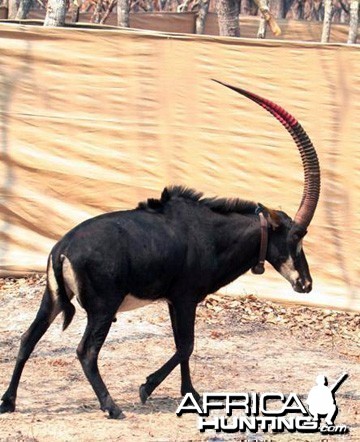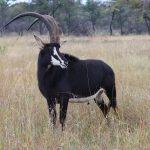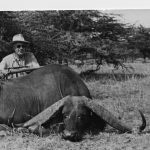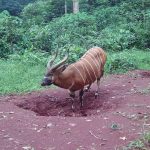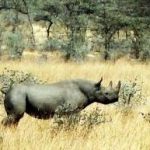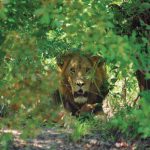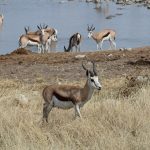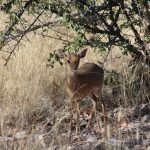New hope for a magnificent African antelope.
When a giant sable, an African antelope native to Angola and once feared to be extinct, was photographed with a trail camera in a forest reserve in this civil-war-ravaged country in 2004, it excited the interest of the hunting and conservation community. Dr. Pedro vaz Pinto of the Centre of Studies and Scientific Research at the Catholic University of Angola, who was instrumental in rediscovering the giant sable, spearheaded an ambitious and successful relocation effort this summer in hopes of protecting the few remaining giant sable and encouraging them to breed.
This giant sable is part of an effort to restore the population of these rare animals in Angola.
Giant sable resemble the common sable found in southern and eastern Africa, but they have much larger horns. Horns longer than 60 inches have been recorded, with tip-to-tip spreads of as much as 35 inches. Their range is restricted to northcentral Angola between the Cuanza and Luando rivers, mainly in and around the Luando Reserve and Cangandala National Park.
The first part of the relocation operation involved finding and capturing as many of the remaining purebred sable cows as possible in Cangandala National Park and transporting them to a 400-hectare breeding enclosure constructed for the purpose. Nine pure sable females were found and captured, all of them between eight and fourteen years old. Because no giant sable bulls existed in the area where the cows were found, some of the giant sable had bred with roan antelope, producing hybrids. Scientists were careful to translocate only animals they positively identified as true Hippotragus niger variani.
The darting and capture operation was carried out via helicopter, with Botswana pilot Barney O’Hara flying the chopper, Pedro vaz Pinto handling the maps, and veterinarian Pete Morkel doing the darting. Scientists Jeremy Anderson and Richard Estes also assisted with the effort. All of the darted animals were marked with color ear tags, and some received VHF or GPS/GSM tracking collars. Those that were relocated into the sanctuary area had their horn tips removed.
The team then moved to the Luando Reserve, where another small group of giant sable had been discovered—eight bulls and three females, two with calves. Many of these animals also received tracking collars, and, most significantly, one of the bulls was darted and translocated to the enclosure in Cangandala. After spending some time in a holding pen where the animals were able to adapt to their new surroundings, the bull and his new harem of nine females was released into the larger enclosure where, it is hoped, they will thrive and breed.
The operation, described by vaz Pinto as “an utter success,” is a huge step forward for the recovery of the giant sable, and it likely happened in the nick of time, based on the advanced age of most of the giant sable that were captured. The scientists will now closely monitor the animals in the breeding enclosure as well as the ones still in the wild in the Luando Preserve.
The giant sable recovery operation was funded by grants from the oil firm Esso Angola, the telephone company UNITEL, and the German Technical Corporation, and the TUSK Trust, and received assistance from scientists from Botswana and South Africa as well as the Angolan military. Read further details about the giant sable restoration efforts in the free online publication African Indaba:
